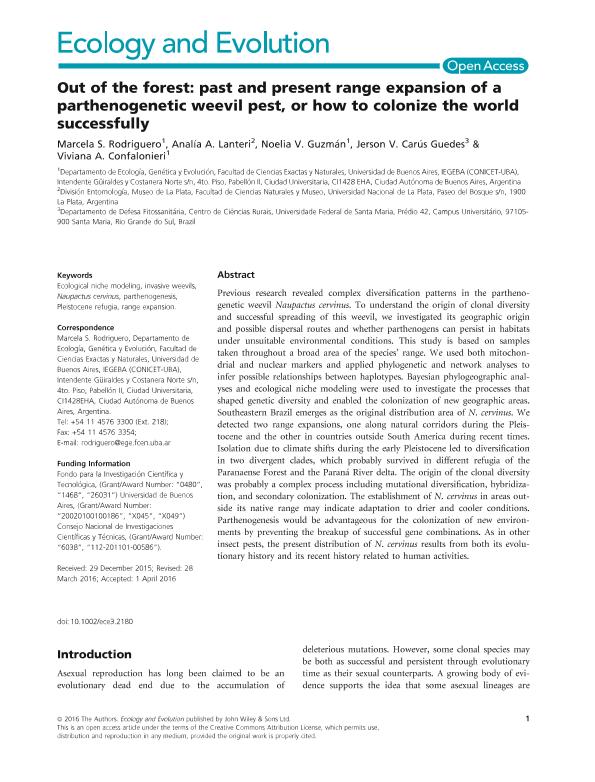Mostrar el registro sencillo del ítem
dc.contributor.author
Rodriguero, Marcela Silvina

dc.contributor.author
Lanteri, Analía Alicia

dc.contributor.author
Guzman, Noelia Veronica

dc.contributor.author
Carús Guedes, Jerson V.
dc.contributor.author
Confalonieri, Viviana Andrea

dc.date.available
2018-08-06T18:58:53Z
dc.date.issued
2016-08
dc.identifier.citation
Rodriguero, Marcela Silvina; Lanteri, Analía Alicia; Guzman, Noelia Veronica; Carús Guedes, Jerson V.; Confalonieri, Viviana Andrea; Out of the forest: past and present range expansion of a parthenogenetic weevil pest, or how to colonize the world successfully; John Wiley and Sons Ltd; Ecology and Evolution; 6; 15; 8-2016; 5431-5445
dc.identifier.issn
2045-7758
dc.identifier.uri
http://hdl.handle.net/11336/54305
dc.description.abstract
Previous research revealed complex diversification patterns in the parthenogenetic weevil Naupactus cervinus. To understand the origin of clonal diversity and successful spreading of this weevil, we investigated its geographic origin and possible dispersal routes and whether parthenogens can persist in habitats under unsuitable environmental conditions. This study is based on samples taken throughout a broad area of the species’ range. We used both mitochondrial and nuclear markers and applied phylogenetic and network analyses to infer possible relationships between haplotypes. Bayesian phylogeographic analyses and ecological niche modeling were used to investigate the processes that shaped genetic diversity and enabled the colonization of new geographic areas. Southeastern Brazil emerges as the original distribution area of N. cervinus. We detected two range expansions, one along natural corridors during the Pleistocene and the other in countries outside South America during recent times. Isolation due to climate shifts during the early Pleistocene led to diversification in two divergent clades, which probably survived in different refugia of the Paranaense Forest and the Paraná River delta. The origin of the clonal diversity was probably a complex process including mutational diversification, hybridization, and secondary colonization. The establishment of N. cervinus in areas outside its native range may indicate adaptation to drier and cooler conditions. Parthenogenesis would be advantageous for the colonization of new environments by preventing the breakup of successful gene combinations. As in other insect pests, the present distribution of N. cervinus results from both its evolutionary history and its recent history related to human activities.
dc.format
application/pdf
dc.language.iso
eng
dc.publisher
John Wiley and Sons Ltd
dc.rights
info:eu-repo/semantics/openAccess
dc.rights.uri
https://creativecommons.org/licenses/by-nc-sa/2.5/ar/
dc.subject
Ecological Niche Modeling
dc.subject
Invasive Weevils
dc.subject
Naupactus Cervinus
dc.subject
Parthenogenesis
dc.subject
Pleistocene Refugia
dc.subject
Range Expansion
dc.subject.classification
Otras Ciencias Biológicas

dc.subject.classification
Ciencias Biológicas

dc.subject.classification
CIENCIAS NATURALES Y EXACTAS

dc.title
Out of the forest: past and present range expansion of a parthenogenetic weevil pest, or how to colonize the world successfully
dc.type
info:eu-repo/semantics/article
dc.type
info:ar-repo/semantics/artículo
dc.type
info:eu-repo/semantics/publishedVersion
dc.date.updated
2018-08-06T18:05:29Z
dc.journal.volume
6
dc.journal.number
15
dc.journal.pagination
5431-5445
dc.journal.pais
Reino Unido

dc.journal.ciudad
Londres
dc.description.fil
Fil: Rodriguero, Marcela Silvina. Consejo Nacional de Investigaciones Científicas y Técnicas. Oficina de Coordinación Administrativa Ciudad Universitaria. Instituto de Ecología, Genética y Evolución de Buenos Aires. Universidad de Buenos Aires. Facultad de Ciencias Exactas y Naturales. Instituto de Ecología, Genética y Evolución de Buenos Aires; Argentina
dc.description.fil
Fil: Lanteri, Analía Alicia. Consejo Nacional de Investigaciones Científicas y Técnicas; Argentina. Universidad Nacional de La Plata. Facultad de Ciencias Naturales y Museo. División Entomología; Argentina
dc.description.fil
Fil: Guzman, Noelia Veronica. Consejo Nacional de Investigaciones Científicas y Técnicas. Oficina de Coordinación Administrativa Ciudad Universitaria. Instituto de Ecología, Genética y Evolución de Buenos Aires. Universidad de Buenos Aires. Facultad de Ciencias Exactas y Naturales. Instituto de Ecología, Genética y Evolución de Buenos Aires; Argentina
dc.description.fil
Fil: Carús Guedes, Jerson V.. Universidade Federal de Santa Maria; Brasil
dc.description.fil
Fil: Confalonieri, Viviana Andrea. Consejo Nacional de Investigaciones Científicas y Técnicas. Oficina de Coordinación Administrativa Ciudad Universitaria. Instituto de Ecología, Genética y Evolución de Buenos Aires. Universidad de Buenos Aires. Facultad de Ciencias Exactas y Naturales. Instituto de Ecología, Genética y Evolución de Buenos Aires; Argentina
dc.journal.title
Ecology and Evolution
dc.relation.alternativeid
info:eu-repo/semantics/altIdentifier/doi/https://dx.doi.org/10.1002/ece3.2180
dc.relation.alternativeid
info:eu-repo/semantics/altIdentifier/url/https://onlinelibrary.wiley.com/doi/abs/10.1002/ece3.2180
Archivos asociados
